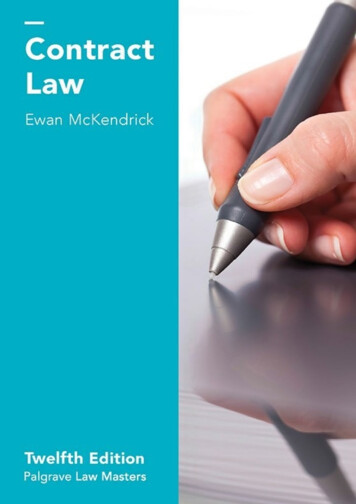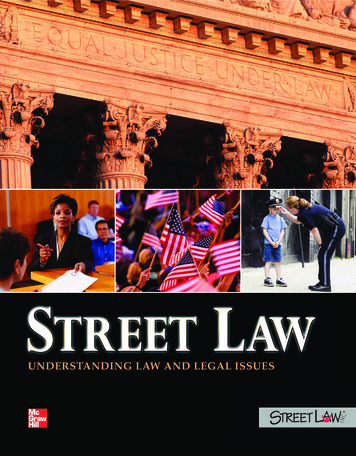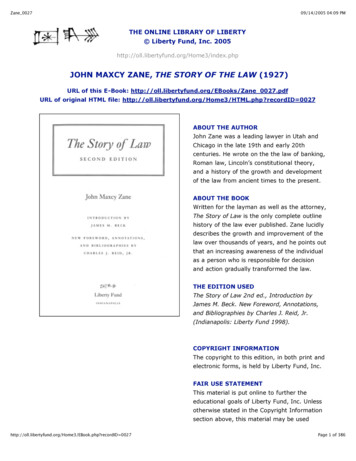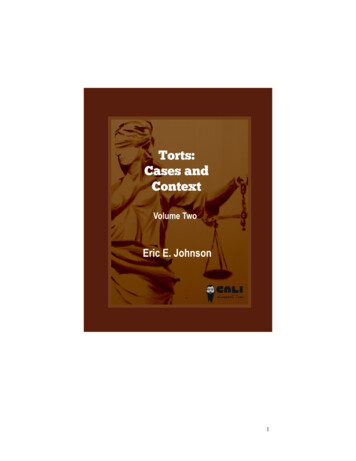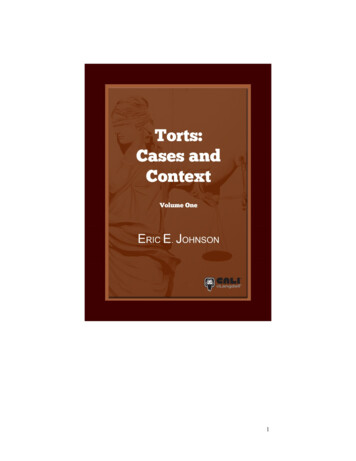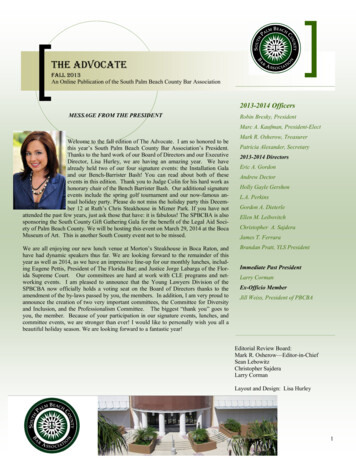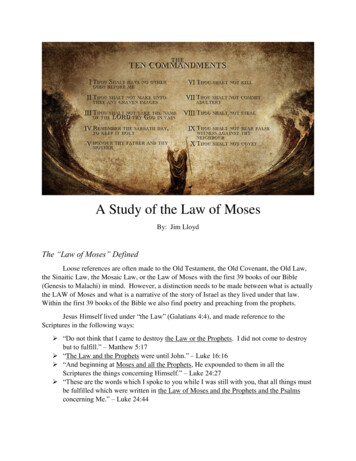
Transcription
A Study of the Law of MosesBy: Jim LloydThe “Law of Moses” DefinedLoose references are often made to the Old Testament, the Old Covenant, the Old Law,the Sinaitic Law, the Mosaic Law, or the Law of Moses with the first 39 books of our Bible(Genesis to Malachi) in mind. However, a distinction needs to be made between what is actuallythe LAW of Moses and what is a narrative of the story of Israel as they lived under that law.Within the first 39 books of the Bible we also find poetry and preaching from the prophets.Jesus Himself lived under “the Law” (Galatians 4:4), and made reference to theScriptures in the following ways: “Do not think that I came to destroy the Law or the Prophets. I did not come to destroybut to fulfill.” – Matthew 5:17 “The Law and the Prophets were until John.” – Luke 16:16 “And beginning at Moses and all the Prophets, He expounded to them in all theScriptures the things concerning Himself.” – Luke 24:27 “These are the words which I spoke to you while I was still with you, that all things mustbe fulfilled which were written in the Law of Moses and the Prophets and the Psalmsconcerning Me.” – Luke 24:44
“Philip found Nathanael and said to him, ‘We have found Him of whom Moses in thelaw, and also the Prophets, wrote – Jesus of Nazareth, the son of Joseph.” – John 1:45 Paul also referenced “the Law and the Prophets” in Acts 13:15 & 24:14.Please note the distinction made by Jesus between the Law of Moses and the other inspiredwritings of the Prophets and those found in the book of Psalms. The Jews considered there to be3 general categories/collections of writings: The Law (Torah) – Genesis, Exodus, Leviticus, Numbers, and Deuteronomy. The Prophets (Neviim) – Joshua, Judges, 1&2 Samuel, 1&2 Kings, Isaiah, Jeremiah,Ezekiel, the 12 Minor Prophets. The Writings (Kethubim) – Psalms, Proverbs, Job, Ruth, Song of Solomon, Ecclesiastes,Lamentations, Esther, Daniel, Ezra, and Nehemiah, 1&2 Chronicles.Jesus even referred to Psalm 82:6 as “law” in John 10:34 when he said, “Is it not written inyour law, ‘I said, “You are gods .” This may help explain why Jesus at times referred to theentire 39 books of Scripture in just 2 categories (the Law and the Prophets).For the purpose of this study, we will be looking specifically at the Law of Moses, that is, therules and regulations given by God, through Moses, to the children of Israel. The reason theselaws are referred to as the “Law of Moses,” when they are in fact Laws from God, is simplybecause Moses was the one who delivered the law. Moses is not the author of these laws, he wasmerely God’s spokesman to Israel (see Exodus 19).2
The Purpose of the LawThe most obvious reason for God giving mankind a law is well stated by Paul in his firstletter to Timothy:“Now the purpose of the commandment is love from a pure heart, from a goodconscience, and from sincere faith, from which some, having strayed, have turned asideto idle talk, desiring to be teachers of the law, understanding neither what they say nor thethings which they affirm. But we know that the law is good if one uses it lawfully,knowing this: that the law is not made for a righteous person, but for the lawless andinsubordinate, for the ungodly and for sinners, for the unholy and profane, for murderersof fathers and murderers of mothers, for manslayers, for fornicators, for sodomites, forkidnappers, for liars, for perjurers, and if there is any other thing that is contrary to sounddoctrine .” – 1 Timothy 1:5-11Paul digs a little deeper for us in Romans 7, where he tells Christians that they have beendelivered from the Law of Moses (vs. 6), but that isn’t because the Law of Moses was bad. Infact, Paul describes it as “holy” (vs. 12) and “spiritual” (vs. 14). The problem was not the law;the problem was man. Paul writes:“What shall we say then? Is the law sin? Certainly not! On the contrary, I would nothave known sin except through the law. For I would not have known covetousness unlessthe law had said, ‘You shall not covet.’” – Romans 7:7Yet the Law of Moses was purposed to do more than just point out sin. The Law was purposedto point people to Jesus.Galatians 3:19-25 is a great text to consider for this discussion. I would like to point outverse 24 specifically: “Therefore the law was our tutor to bring us to Christ.” Paul says inRomans 10:4, “For Christ is the end of the law for righteousness to everyone who believes.”3
See also Acts 13:38-39:“Therefore let it be known to you, brethren, that through this Man is preached to you theforgiveness of sins; and by Him everyone who believes is justified from all things fromwhich you could not be justified by the law of Moses.”Therefore, the purpose of the Law of Moses was to both point out sin, and to preparemankind for Jesus Christ. The law was not to curse man to a miserable existence or to regulateand restrict him to a boring life. On the contrary, God’s laws have always been purposed toprotect and to guide. God’s Law for Israel, delivered by Moses, was preparatory andforeshadowed greater things that would come through the ultimate Lawgiver –Jesus Christ.The scope of this study will be to examine the specific laws God gave to Israel, with thegoal of determining how these things point to Jesus.More than Just Ten CommandmentsGod has been ordering His creation to do, or not do, certain things since the beginning(Genesis 2:15-16). Mankind has also been worshipping and serving God since the beginning(Genesis 4:4). Before the Law of Moses was ever delivered, God expected His creation to liveby faith and trust in His word (whether verbal or written). Hebrews 1:1-2 reminds us that Godhas always communicated with His creation through various means.However, it appears to be the case that the Law of Moses was the first “codified” law. Itwas specifically delivered to the nation of Israel, the nation God promised to bring about throughthe seed line of Abraham (Genesis 12:2). Exodus 20 even opens with God addressing the nationhe had just redeemed from the land of Egypt. The commandments that follow in that chapter arenow famously known as the “Ten Commandments.”4
Yet there are far more than 10 in total. Scholars seem to agree that there are 613commandments, 248 positive commandments (do / perform) and 365 negative commandments(do not / abstain). Visit Wikipedia and search the phrase “613 commandments” to see thecomprehensive list.God’s Law to the Israelite nation goes far beyond circumcision and Sabbath day worshipservices of sacrifices and offerings. A few of the broader categories are as follows: AgricultureLaborEducationFamily LawBusiness LawCriminal LawHealth CodesSocial ProgramsAnd many more .Some like to make a distinction between ceremonial, civil, and moral laws. While filteringthe various laws or making distinctions may serve some purpose in personal Bible study, pleasebe careful not to be swayed by some who will make these distinctions in order to push theirbelief that Jesus nailed one part of the law to the cross, but not the other(s). There is no suchdistinction made in the New Testament. The Law of Moses, in its entirety, was nailed to thecross, and we are now under the Law of Christ (Romans 7:2-4, 10:4, Galatians 3:10-14, 3:24-25,Ephesians 2:14-16, Colossians 2:13-14). Having said that, we must avoid the extremes somehave gone to by saying there is no value in studying the Old Testament at all.5
Please note the distinction made by Jesus between the Law of Moses and the other inspired writings of the Prophets and those found in the book of Psalms. The Jews considered there to be 3 general categories/collections of writings: The Law (Torah) - Genesis, Exodus, Leviticus, Numbers, and Deuteronomy.




